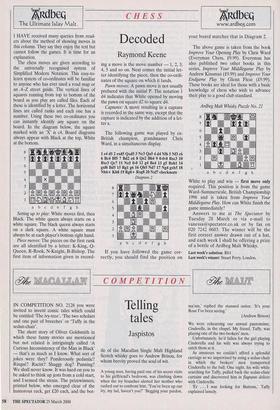; RdbN
The Ultimate Islay Malt.
Rdbeq
www.ardbes.com
CHESS
Decoded
Raymond Keene
I HAVE received many queries from read- ers about the method of showing moves in this column. They say they enjoy the text but cannot follow the games. It is time for an explanation.
The chess moves are given according to the universally recognised system of Simplified Modern Notation. This easy-to- learn system of co-ordinates will be familiar to anyone who has ever used a road map or an A–Z street guide. The vertical lines of squares running from top to bottom of the board as you play are called files. Each of these is identified by a letter. The horizontal lines are called ranks and each one has a number. Using these two co-ordinates you can instantly identify any square on the board. In the diagram below, the square marked with an 'X' is c4. Board diagrams always appear with Black at the top, White at the bottom.
Setting up to play: White moves first, then Black. The white queen always starts on a white square. The black queen always starts on a dark square. A white square must always be at each player's bottom right hand.
Piece moves: The pieces on the first rank are all identified by a letter: K-King, Q- Queen, R-Rook, N-Knight, B-Bishop. The first item of information given in record- ing a move is the move number — 1, 2, 3, 4, 5 and so on. Next comes the initial let- ter identifying the piece, then the co-ordi- nates of the square on which it lands.
Pawn moves: A pawn move is not usually prefaced with the initial P. The notation 1 d4 indicates that White opened by moving the pawn on square d2 to square d4.
Captures: A move resulting in a capture is recorded in the same way, except that the capture is indicated by the addition of a let- ter x.
The following game was played by ex- British champion, grandmaster Chris Ward, in a simultaneous display.
1 e4 d5 2 exd5 Qxd5 3 Nc3 Qa5 4 d4 Nf6 5 Nt3 c6 6 Bc4 Bf5 7 Bd2 e6 8 Qe2 Bb4 9 0-0-0 Bxc3 10 Bxc3 Qc7 11 Ne5 0-0 12 g4 Be4 13 g5 Bxhl 14 gxf6 Bd5 15 Rgl g6 16 Qh5 Nd7 17 Ng4 mch5 18 Nh6+ Kb8 19 Rg8+ Rxg8 20 Nxf7 checkmate Diagram 2
If you have followed the game cor- rectly, you should find the position on your board matches that in Diagram 2.
The above game is taken from the book Improve Your Opening Play by Chris Ward (Everyman Chess, £9.99). Everyman has also published two other books in this series, Improve Your Middlegame Play by Andrew Kinsman (£9.99) and Improve Your Endgame Play by Glenn Flear (£9.99). These books are ideal for those with a basic knowledge of chess who wish to advance their play to a good club standard.
Ardbeg Malt Whisky Puzzle No. 21 White to play and win — first move only required. This position is from the game Ward–Summerscale, British Championship 1996 and is taken from Improve Your Middlegame Play. How can White finish the game immediately?
Answers to me at The Spectator by Tuesday 28 March or via e-mail to vanessa@spectator.co.uk or by fax on 020 7242 0603. The winner will be the first correct answer drawn out of a hat, and each week I shall be offering a prize of a bottle of Ardbeg Malt Whisky.
Last week's solution: Rbl Last week's winner: Stuart Perry, London.


































































 Previous page
Previous page